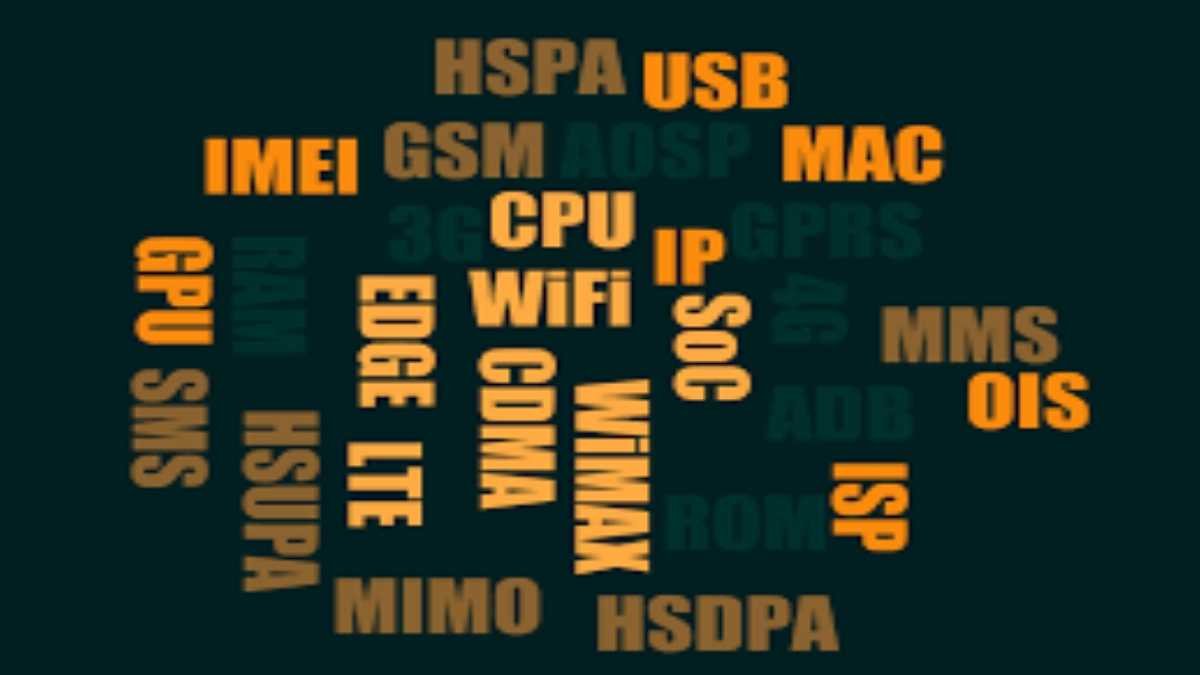In the fast-paced realm of technology, a slew of abbreviations and acronyms can leave even the tech-savvy scratching their heads. To demystify the digital language, let’s delve into a comprehensive guide to commonly used technology abbreviations and their meanings.
1. AI – Artificial Intelligence
- Meaning: Simulating human intelligence in machines, AI encompasses tasks like learning, reasoning, problem-solving, and perception.
2. IoT – Internet of Things
- Meaning: The interconnection of everyday devices to the internet, enabling them to send and receive data. Examples include smart home devices and wearable tech.
3. VR – Virtual Reality
- Meaning: Creating immersive, computer-generated environments that users can interact with, often using specialized headsets.
4. AR – Augmented Reality
- Meaning: Enhancing real-world experiences by overlaying digital information, such as graphics or data, onto the physical environment.
5. API – Application Programming Interface
- Meaning: A set of rules that allows different software applications to communicate with each other.
Basic Microsoft Word Shortcuts you need to know
6. HTTPS – Hypertext Transfer Protocol Secure
- Meaning: A secure version of the HTTP protocol used for secure communication over a computer network, commonly the internet.
7. SSD – Solid State Drive
- Meaning: A storage device that uses NAND-based flash memory to store data, offering faster access times and durability compared to traditional hard disk drives (HDD).
8. DNS – Domain Name System
- Meaning: Translates human-readable domain names into IP addresses, facilitating the identification of computer systems on a network.
9. HTML – Hypertext Markup Language
- Meaning: The standard markup language for creating web pages and web applications.
10. VPN – Virtual Private Network
- Meaning: A secure connection that allows users to access a private network over the internet, ensuring data confidentiality and security.
Everything You Need To Know About /alesowshi5c code
11. CPU – Central Processing Unit
- Meaning: Often referred to as the brain of the computer, the CPU performs the majority of processing tasks, executing instructions of a computer program.
12. GPU – Graphics Processing Unit
- Meaning: Specialized hardware designed to accelerate the rendering of graphics and images, commonly used in gaming and video editing.
13. LAN – Local Area Network
- Meaning: A network that connects computers and devices within a limited geographical area, such as a home, office, or campus.
14. WAN – Wide Area Network
- Meaning: A network that covers a broader geographical area, connecting multiple LANs and facilitating communication over long distances.
15. BIOS – Basic Input/Output System
- Meaning: Firmware that initializes and tests hardware components during a computer’s startup process, ensuring they function correctly before the operating system kicks in.
16. URL – Uniform Resource Locator
- Meaning: The address used to access resources on the internet, specifying the protocol (e.g., HTTP, HTTPS), domain name, and path.
17. FTP – File Transfer Protocol
- Meaning: A standard network protocol used to transfer files from one host to another over a TCP-based network, commonly used for uploading website files.
18. SMTP – Simple Mail Transfer Protocol
- Meaning: A protocol used for sending and receiving email, governing the transmission of messages between email servers.
19. VoIP – Voice over Internet Protocol
- Meaning: Technology that allows voice communication and multimedia sessions over the internet, often used for making phone calls over the web.
20. PDF – Portable Document Format
- Meaning: A file format that presents documents, including text formatting and images, in a manner independent of application software, hardware, and operating systems.
How Do I Easily Fix D3dx9_43.dll is Missing?
21. LAN – Neural Network
- Meaning: An interconnected system of nodes, inspired by the structure of the human brain, designed to learn and make decisions without explicit programming. Widely used in machine learning.
22. SDK – Software Development Kit
- Meaning: A set of software tools and libraries that developers use to create applications for specific platforms, frameworks, or programming languages.
23. DNS – Content Delivery Network (CDN)
- Meaning: A network of distributed servers that work together to deliver web content, enhancing performance and reliability by minimizing latency.
24. SSL/TLS – Secure Sockets Layer/Transport Layer Security
- Meaning: Protocols that secure internet communication, providing encryption and authentication for data transmitted between systems, commonly used for secure online transactions.
25. OCR – Optical Character Recognition
- Meaning: Technology that converts different types of documents, such as scanned paper documents, PDFs, or images, into editable and searchable data.
26. CMS – Content Management System
- Meaning: A software application or set of related programs that enable users to create, manage, and modify digital content, often used for websites.
27. SaaS – Software as a Service
- Meaning: A software distribution model where applications are hosted by a third-party provider and made available to customers over the internet.
28. RAM – Random Access Memory
- Meaning: Computer memory that is used to store data and machine code currently being used and processed by a computer, providing quick access for efficient operation.
29. API – RESTful API
- Meaning: Representational State Transfer, a set of architectural principles for creating web services, ensuring interoperability between computer systems on the internet.
30. CAD – Computer-Aided Design
- Meaning: The use of computer systems to assist in the creation, modification, analysis, or optimization of a design, commonly used in engineering and architecture.
How Do I Easily Fix The Application Was Unable to Start (0xc000007b) error in Windows?
31. RPA – Robotic Process Automation
- Meaning: The use of software robots or “bots” to automate repetitive tasks, allowing businesses to streamline processes and increase efficiency.
32. DNS – Deep Learning
- Meaning: A subset of machine learning that involves artificial neural networks with multiple layers (deep neural networks), capable of learning and making decisions without explicit programming.
33. CCTV – Closed-Circuit Television
- Meaning: A system of video cameras used for surveillance purposes, transmitting signals to a specific set of monitors or recording devices.
34. SQL – Structured Query Language
- Meaning: A domain-specific language used for managing and manipulating relational databases, allowing users to query and update data.
35. API – GraphQL
- Meaning: A query language and runtime for APIs, designed to provide a more efficient, powerful, and flexible alternative to traditional REST APIs.
36. IPv6 – Internet Protocol version 6
- Meaning: The most recent version of the Internet Protocol, designed to replace IPv4, providing a larger address space to accommodate the growing number of devices connected to the internet.
37. URL – Uniform Resource Locator
- Meaning: A specific character string that constitutes a reference to a resource, specifying the means to access it, often on the World Wide Web.
38. CSV – Comma-Separated Values
- Meaning: A simple file format used to store tabular data, where each line of the file represents a row, and each value within that row is separated by commas.
39. IDE – Integrated Development Environment
- Meaning: A software application that provides comprehensive facilities to programmers for software development, combining code editing, debugging, and build automation.
40. SSL/TLS – Two-Factor Authentication (2FA)
- Meaning: A security process in which a user provides two different authentication factors to verify their identity, often combining a password with a unique code sent to a mobile device.
Basic computer skills you need to have
41. SDK – ARPU: Average Revenue Per User
- Meaning: A key performance indicator used by businesses to evaluate the average amount of revenue generated by each user, often employed in the context of mobile apps and subscription services.
42. BI – Business Intelligence
- Meaning: Technologies, processes, and tools that help organizations analyze and make informed decisions based on data, fostering a data-driven approach to business strategies.
43. CMS – WYSIWYG: What You See Is What You Get
- Meaning: An editing interface that allows content creators to see the final appearance of their content as they edit it, simplifying the content creation process.
44. VoIP – PBX: Private Branch Exchange
- Meaning: A private telephone network used within an organization, enabling users to communicate internally and externally using different communication channels.
45. IoT – M2M: Machine-to-Machine
- Meaning: Direct communication between devices without human intervention, often used in the context of the Internet of Things (IoT) for seamless data exchange.
46. HTML – CSS: Cascading Style Sheets
- Meaning: A style sheet language used for describing the look and formatting of a document written in HTML, enhancing the visual presentation of web pages.
47. VPN – IPsec: Internet Protocol Security
- Meaning: A suite of protocols for securing internet communications, providing authentication and encryption for data transferred between devices.
48. DNS – DoS: Denial of Service
- Meaning: A cyber-attack that aims to make a computer or network resource unavailable to its intended users, typically by overwhelming the targeted system with traffic.
49. SSD – RAID: Redundant Array of Independent Disks
- Meaning: A storage technology that combines multiple disk drives into a single logical unit to improve data storage performance, reliability, or both.
50. LAN – PoE: Power over Ethernet
- Meaning: A technology that enables electrical power to be transmitted over Ethernet cables, commonly used to power network devices like IP cameras and VoIP phones.
51. API – CRUD: Create, Read, Update, Delete
- Meaning: A set of basic operations used in database management and web development, representing the four main functions for persistent storage.
52. URL – UTM: Urchin Tracking Module
- Meaning: A set of parameters added to a URL to track and analyze the effectiveness of online marketing campaigns, providing insights into user behavior.
53. SEO – SERP: Search Engine Results Page
- Meaning: The page displayed by a search engine in response to a user’s query, showing a list of web pages with relevant content.
54. API – SOAP: Simple Object Access Protocol
- Meaning: A protocol for exchanging structured information in web services, allowing programs running on different operating systems to communicate with each other.
55. RPA – BPM: Business Process Management
- Meaning: A discipline that uses various methods to discover, model, analyze, measure, improve, optimize, and automate business processes.
56. SMTP – IMAP: Internet Message Access Protocol
- Meaning: An internet standard protocol used by email clients to retrieve messages from a mail server, enabling users to access their email from multiple devices.
57. VPN – PPTP: Point-to-Point Tunneling Protocol
- Meaning: A method for implementing virtual private networks, often used for secure remote access connections.
58. API – JSON: JavaScript Object Notation
- Meaning: A lightweight data interchange format that is easy for humans to read and write, and easy for machines to parse and generate.
59. CAD – CAM: Computer-Aided Manufacturing
- Meaning: The use of computer software and machinery to facilitate and automate the manufacturing process, ensuring precision and efficiency.
60. IoT – NFC: Near Field Communication
- Meaning: A set of communication protocols that enable two electronic devices to establish communication by bringing them within a short distance of each other.
Some other abbreviations and their meanings are listed in the table below.
| Abbreviations | Meaning |
|---|---|
| PAN | permanent account number. |
| portable document format. | |
| SIM | Subscriber Identity Module |
| ATM | Automated Teller machine |
| IFSC | Indian Financial System Code |
| FSSAI | Food Safety & Standards Authority of India |
| Wi-Fi | Wireless fidelity |
| Global Organization Of Oriented Group Language Of Earth | |
| YAHOO | Yet Another Hierarchical Officious Oracle |
| WINDOW | Wide Interactive Network Development for Office work Solution |
| COMPUTER | Common Oriented Machine. Particularly United and used under Technical and Educational Research |
| VIRUS | Switches between applications on taskbar |
| UMTS | Universal Mobile Telecommunications System |
| AMOLED | Active-matrix organic light-emitting diode |
| OLED | Organic light-emitting diode |
| IMEI | International Mobile Equipment Identity |
| ESN | Electronic Serial Number |
| UPS | Uninterruptible power supply |
| HDMI | High-Definition Multimedia Interface |
| VPN | Virtual private network |
| APN | Access Point Name |
| LED | Light emitting diode |
| DLNA | Digital Living Network Alliance |
| RAM | Random access memory |
| ROM | Read only memory |
| VGA | Video Graphics Array |
| QVGA | Quarter Video Graphics Array |
| WVGA | Wide video graphics array |
| WXGA | Widescreen Extended Graphics Array |
| USB | Universal serial Bus |
| WLAN | Wireless Local Area Network |
| PPI | Pixels Per Inch |
| LCD | Liquid Crystal Display |
| HSDPA | High speed down-link packet access |
| HSUPA | High-Speed Uplink Packet Access |
| HSPA | High Speed Packet Access |
| GPRS | General Packet Radio Service |
| EDGE | Enhanced Data Rates for Globa Evolution |
| NFC | Near field communication |
| OTG | On-the-go |
| S-LCD | Super Liquid Crystal Display |
| O.S | Operating system |
| SNS | Social network service |
| H.S | HOTSPOT |
| P.O.I | Point of interest |
| GPS | Global Positioning System |
| DVD | Digital Video Disk |
| DTP | Desk top publishing |
| DNSE | Digital natural sound engine |
| OVI | Ohio Video Intranet |
| CDMA | Code Division Multiple Access |
| WCDMA | Wide-band Code Division Multiple Access |
| GSM | Global System for Mobile Communications |
| DIVX | Digital internet video access |
| APK | Authenticated public key |
| J2ME | Java 2 micro edition |
| SIS | Installation source |
| DELL | igital electronic link library |
| ACER | Acquisition Collaboration Experimentation Reflection |
| RSS | Really simple syndication |
| TFT | Thin film transistor |
| AMR | Adaptive Multi-Rate |
| MPEG | Moving Pictures Experts Group |
| IVRS | Interactive Voice Response System |
| HP | Hewlett Packard |
| LAN | Local Area Network |
| ANSI | American National Standards Institute |
| RDBMS | Relational Database Management System |
| INTERNET | Interconnected Network |
| POS | Point of sale |



